And now for the crepe myrtle I worked on in my booth at the BSF convention.

Above is the front and below is the side (that line sounds like a line from a Dan Brown book)

There is a lesson here not only in styling but also in the growing of pre-bonsai stock.
I purchased the tree from D&L Nursery near Ocala Florida (http://www.dlnursery.com/)
It was in a nursery container and I potted it into this training pot this March.
Study this pic

What do you see? Those with a practiced eye will see one trunk chop at least.
There are two.
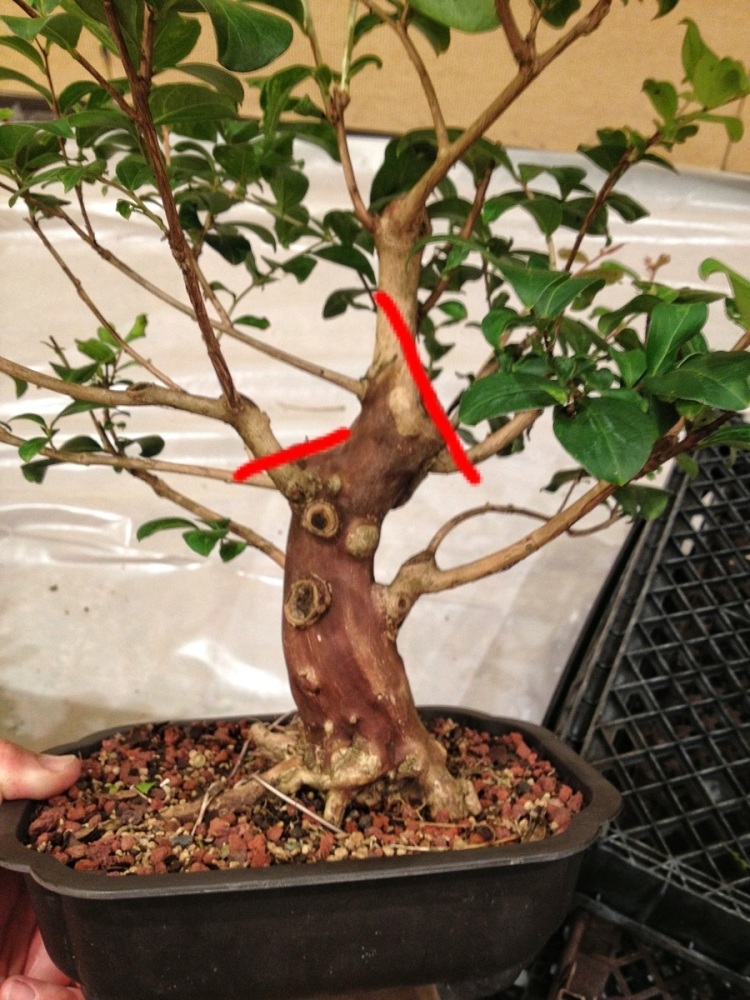
It is often thought by novices that a masterpiece bonsai with a 10 inch trunk and only 2 feet tall was grown by the artist from a seed.
It is true that it may have been a seedling at one point (or a cutting) but its unlikely that the artist who did the first (or sixth) styling grew it that way.
There are exceptions.
Mike Rogers from Deland, FL grows things from scratch.
Erik Wigert from N. Ft. Myers ,FL does.
I do as well.
The difference between the average hobbyist and my friends is the amount of trees we have. I probably have more ficus salicaria cuttings than even the most advanced hobbyist in my club has bonsai trees. The more trees you have the more patience you will have “growing” a bonsai. Or you just don’t have any time to work on it and it grows without you. One of the two.
So, how do you “grow” bonsai trees?
You allow the tree unchecked growth for years, chop it back, allow it to grow more, chop it back, repeat, etc.
That’s what we have with this crepe myrtle.
The first chop site. Completely healed, as you see

And the second chop site

It’s almost healed.
The crepe myrtle is good for these chops because they do heal so well.
I have one more chop to make. I am torn as to where though.
Actually, I have it down to two places.
I could use this front
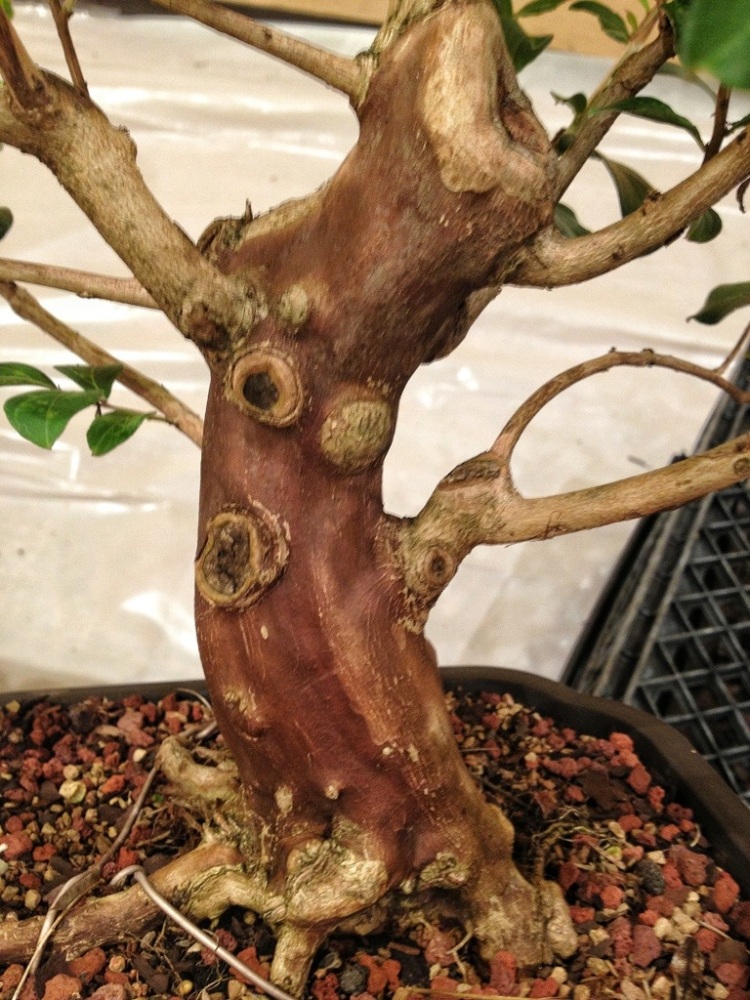
Or this front
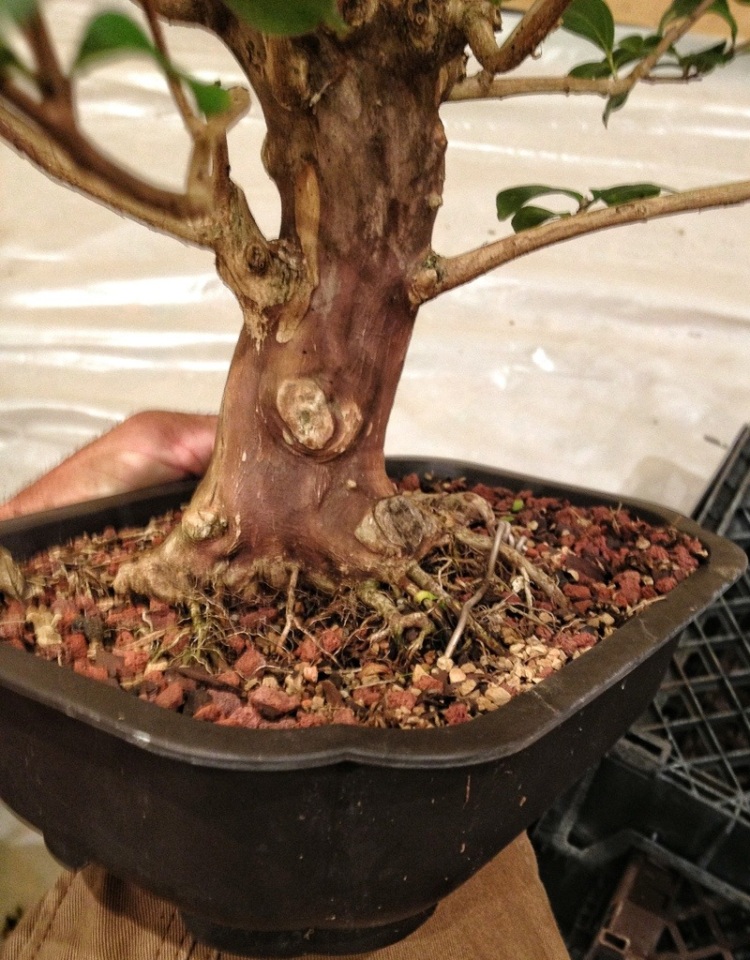
Where will the chop be on each one?
Different places.
Here are some quick sketches.

And
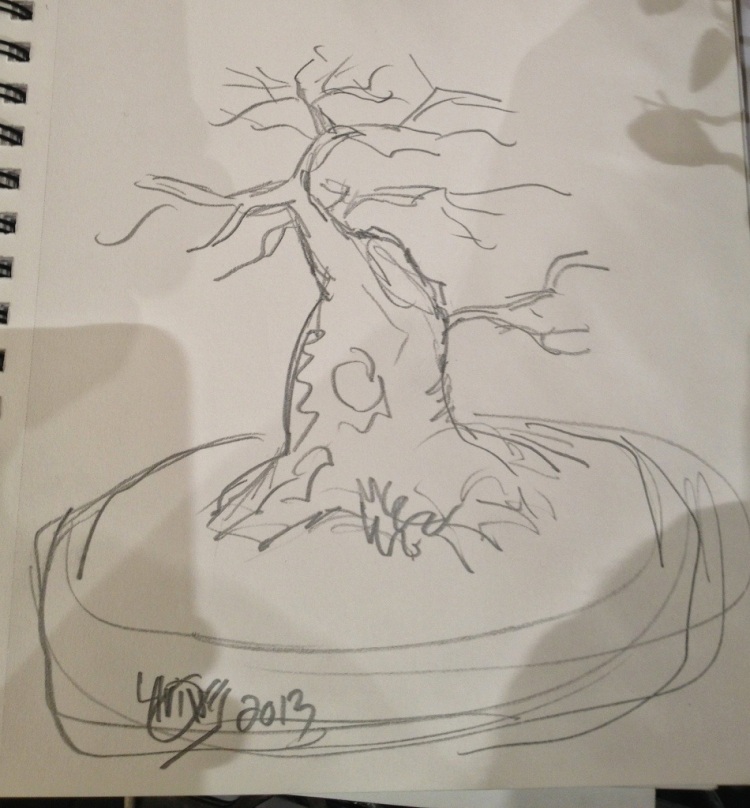
Hmmmmnnnn? You say,..er, hum.
The second one is shorter. By a lot.
The second design would require me to chop the tree here

I would do it to. But not this time.
Why?
First reason: this variety of crepe myrtle is called “Natchez”. Which means white flowers, BIG leaves and fast growth.
In a small tree the last two things are not really desirable.
Secondly, a chop that big (in a bonsai pot) may not heal. It probably would but I’d be fighting the tree (which wants to be bigger than 6 inches tall) and we should listen to the trees. They have much to say. Some of it not repeatable in mixed company.
Which reminds me of a joke:
These two trees had grown up next to each other and were good friends, weathering all types of storms together.
One was an elm and the other was a beech.
One day the trees were shooting the breeze when the beech spied a seedling growing between them.
He says
“Look Elmer, it’s my baby!”
Elmer says
“I think you’re mistaken Beechy old buddy. It looks like one of mine”
Well, this argument, being acted out by immovable objects with limited sight and unbending backs, went as much as can be predicted.
Eventually it came down to name calling and such.
Fortunately, a wood pecker landed on the Elmer’s limb one day.
Beechy says to him
“Woody, old pal, can you settle an argument for us?”
Elmer says
“Please Woody, to save me and Beechy’s friendship, can you go down (you who can fly and all) and tell us what kind of seedling is growing between us? I say it’s my baby, an elm…”
“And I say beech!” Beechy says
Woody shakes his head yes and flies on down.
Tap tap tap…..he cocks his head, tap tap tap. He looks up and nods yes.
And flies back up, landing on Elmer’s branch.
And he says
“Look fellas, I don’t know an elm from a son of a beech, but, I’ll tell you this..that was the best piece of ash I have ever put my pecker into”
And flies off.
Sorry, where was I?
Oh yeah, the crepe myrtle.
Next step. Those are long branches. About the length they’ll stay ultimately.
So goeth the trunk, as with the limbs

Chop

We do this for taper and movement. It is necessary, I promise. If you let the branch thicken without chopping it back you end up with thick, broom handle-like limbs.
Here’s more mayhem (which is legally defined as chopping of limbs, by the way)
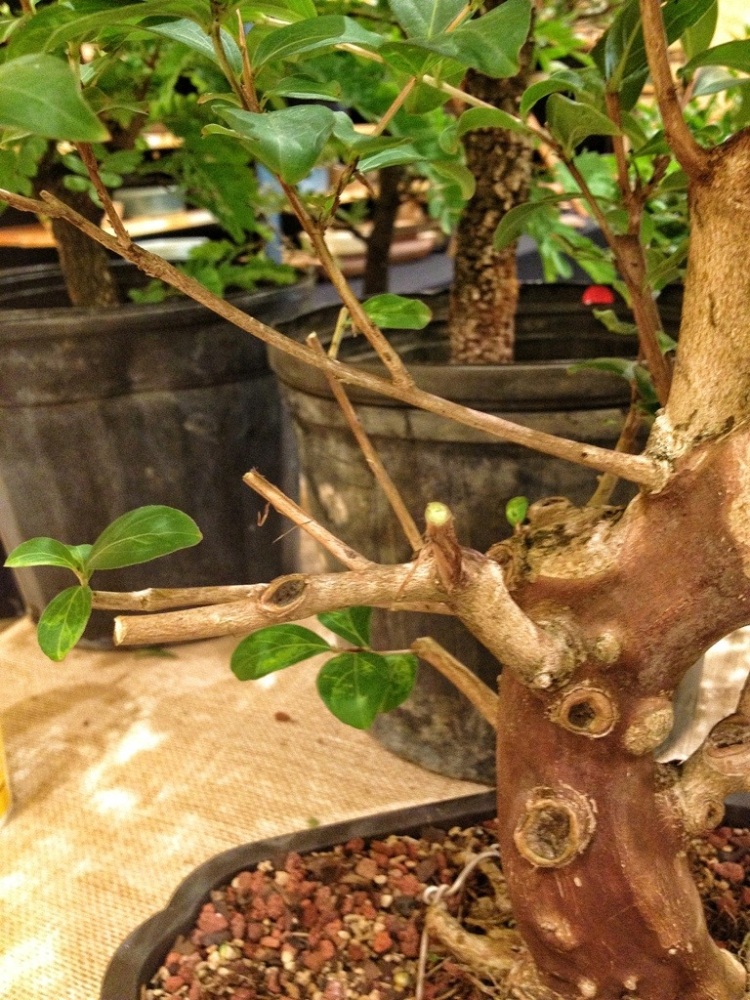
And the third trunk chop

Which, on the drawing, is here

If we study the drawing there are some limbs that need culling:
Inside of a curve-

Wrong angle leaving the trunk-

Too many from one spot

These two

From a different angle
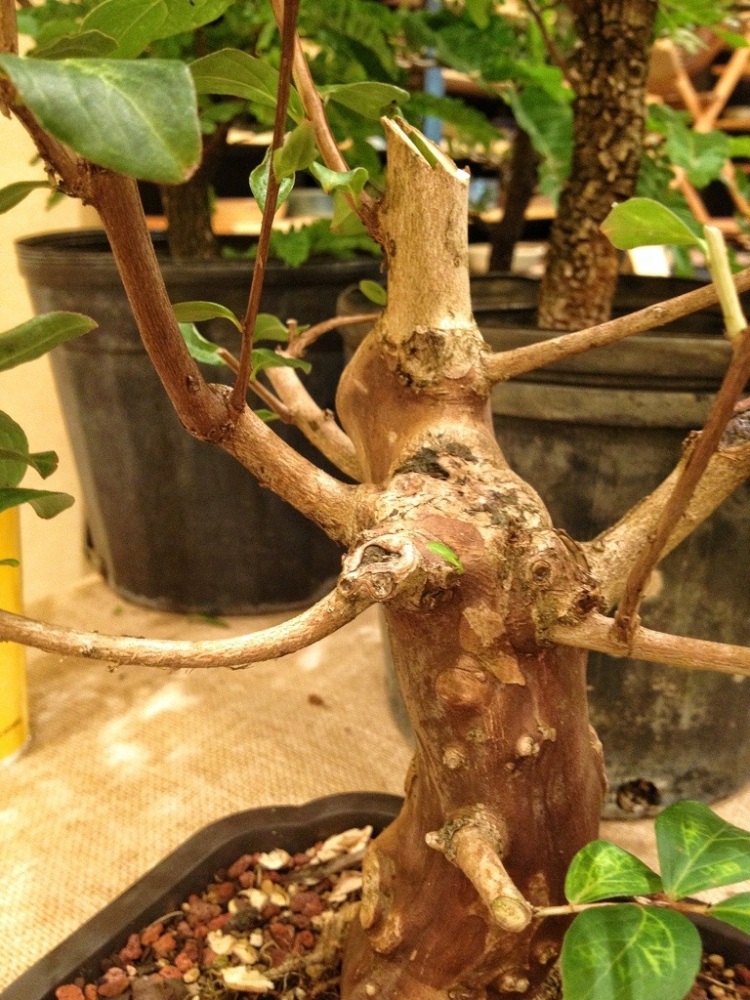
This clump of branches will cause reverse taper (or inverse, or adverse…jeez, sometimes bonsai artists are so obtuse with their acute use of words like shohin, chuhin or Jin and shari. “Look where that Shari meets that Jin on your momiji; it has inverse taper, it’s bigger than the nebari even! And why is a Jin on a momiji anyway? At most I can see a uro, but never Jin and Shari. )

Chop chop chop away all!

So here it is after the carnage:

And some wire
Side

Back
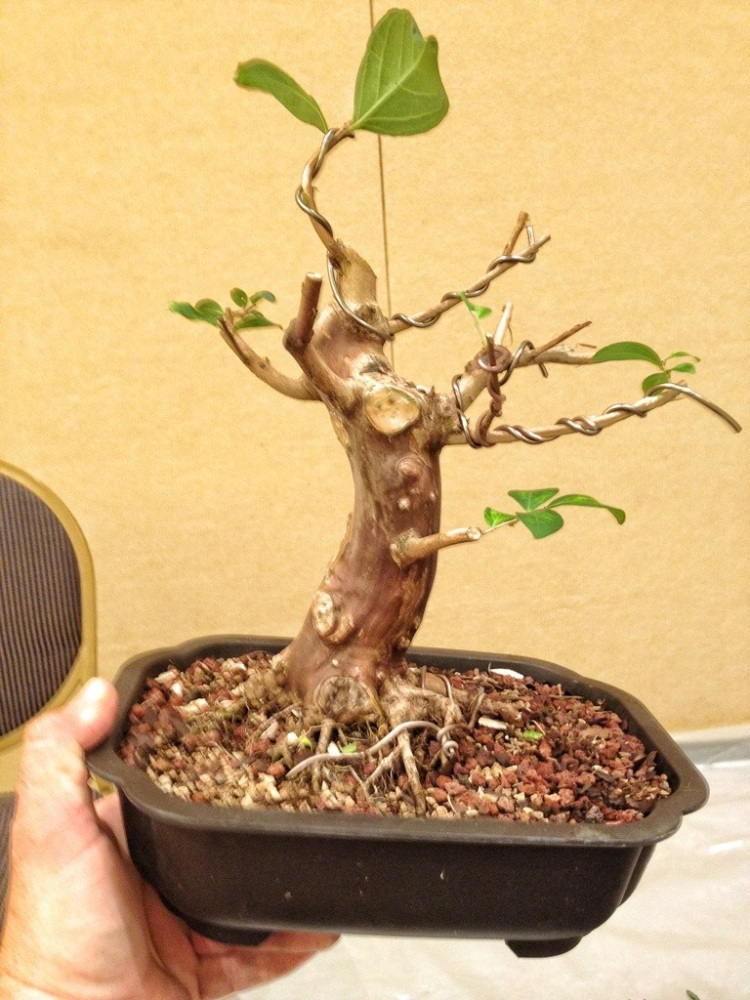
Front
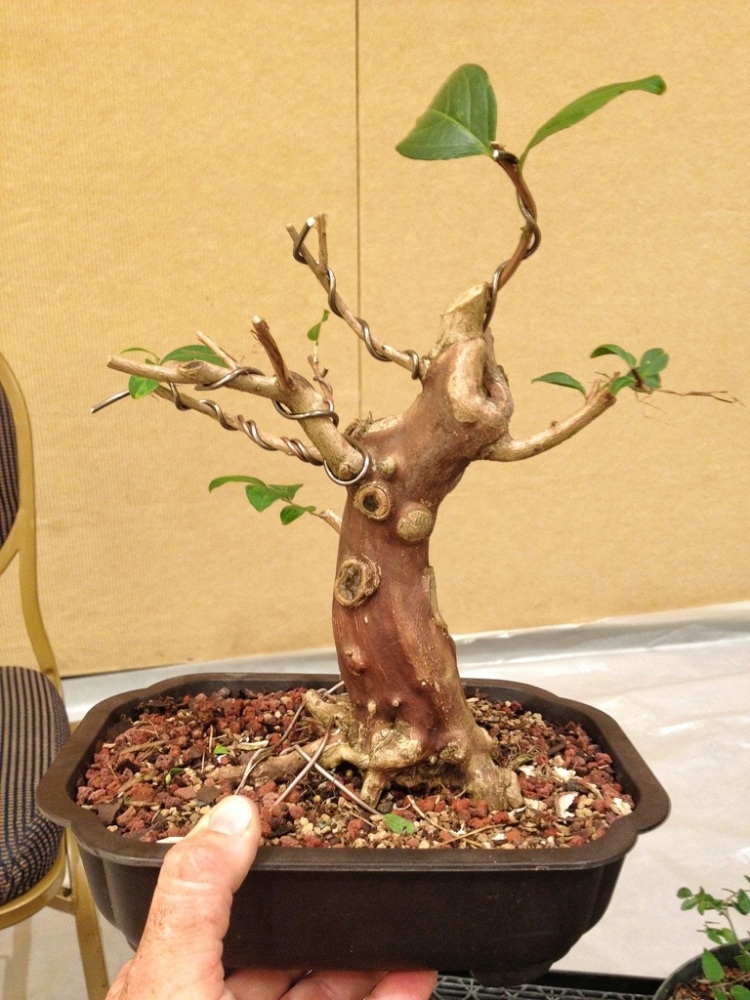
And the sketch to compare

And I’m seeing that I need a little more wire…..
What the main theme behind this post is, yes, you can grow a bonsai, but it takes years. And some techniques that might seem extreme.
I’ll do a quick post soon on a willow leaf ficus I grew from a pencil thin cutting and explain the techniques I used getting there. And show off a bit.
Do you know if the Natchez take branch grafting well? Or will continued cutting of new growth back bud down the trunk? I pulled a 10′ tree out of the gutter (abandoned for green waste pick up) in Feb. It’s about 4′ now but hasn’t back budded farther down the trunk, other than suckers.
LikeLike
They do take grafting really well. One thing I had actually thought of doing on this tree (I won’t because I like the challenge of the big leaves) is to graft one of the dwarf crepe cultivars and replace the branches completely.
Thread grafting works really well; also approach grafting.
LikeLike
I’ve seen a couple of nice dwarf crepes and like them, but like you, I like (and have) the large leaf. With care, I can approach “back-graft” (?) one or two of the suckers. It won’t get the tree as small as I want, but hey, I can chop next year if it works.
Is hot weather a bad time to do approach grafting?
LikeLike
Usually, on a deciduous tree, I graft in the early spring, before the leaves open. I wouldn’t do it in hot weather, there’s just too much stress already.
On ficus I would graft now though
LikeLike
thanks, Adam, for the input on grafting.
LikeLike
I did a chop on a crape this winter and was wondering if I need to just leave it be for a few years. It’s growing like mad, as they do, and I was temped to cut it back to keep it from looking like a bush (insert bush joke here). Just a question after reading this line: “You allow the tree unchecked growth for years, chop it back, allow it to grow more, chop it back, repeat, etc.” Any help would be great. Thanks!
LikeLike
You should choose your main leader and maybe your first branches. Let the leader grow unchecked but trim the bottom branches. The bottom branches aren’t that important as you can grow then back but the leader needs that growth
LikeLike
Adam, I know experience and application are probably the answers. But when you look at a tree after pruning, how do you know what size (gauge) and how many strands of wire that you’re going to use for your styling? Thanks
LikeLike
It is experience but one way to check is to take the wire in your hand and expose an inch. Press the tip against the branch to be bent. If the branch moves, the wire is the right gauge. If the wire moves, go up one gauge.
With aluminum, the rule of thumb is the wire should be just under the size of the branch.
LikeLike
Thanks – that may help a heap!
LikeLike
Post an update? Would enjoy seeing it in 2016.
LikeLike
Wow, that post is three years old. I’ll post some pics on Instagram and Facebook. I can’t do too much work on the tree now as we are going into fall and I don’t want much growth, it’ll take energy away from the reserves it’s been saving up for next spring.
LikeLike
I would like to try creating bonsai trees but I was planning on starting my own trees from seeds. May work may not but I’m willing to give it a try. I’m very new to this. I just love the way they look and I know it takes years and years but is soothing. I’ll study up on all of it but what I would really like to know is this. I live in Louisiana right by Natchez Mississippi and of course the Natchez crepe Myrtle is very popular they are every where but I’ve got seeds from one that is growing by my house that is a watermelon color I’m sorry I don’t know the technical name of it, and I also have seeds for a Chinese wishiteria tree. How old and how big should they be before I put them in a bonsai pot? If you could help me in any way I would really appreciate it. Thank you for your time. You can personally email me with a reply if your able to. Again thank you for your time especially for a very, very new novice who would like a little bit of peace and beauty in her life.
LikeLike
The answer really lies with you. You grow the trunk in a big pot or the ground until it is the size you want, then you begin the bonsai process. Once you do that the trunks don’t tend to get bigger.
LikeLike
Thank you so much. I’ll have to get some books on how to create and care for bonsai trees.
LikeLike